Endoacustica offers, Exclusive Customer Service and free Training
- Bari: +39 080 3026530
- Rome:+39 06 32803486
- Milan:+39 02 67739127
- CATEGORIES
CLOSE
-
Products
- AUDIO SURVEILLANCE
- Spy phone app - Mobile tracker
- Mini voice recorders spy
- Spy earpiece
- Spy listening devices
- * Gsm remote listening devices
- * Analog audio transmitter
- * Encrypted audio transmitter
- * Landline bugging devices
- Analog Digital Transceivers
- Listen through walls devices
- Shotgun Microphone
- Voice Changers
- Mobile phone interception
- VIDEO SURVEILLANCE
- TRACKING DEVICES
- COUNTERSURVEILLANCE
- GADGET
- AUDIO SURVEILLANCE
- company
- services
- contact
- blog
- مقالات
FPV Drone Tactics and Countermeasures
A study of the widespread use of FPV drones (drones with first-person view cameras) in combat has shown that these drones are becoming increasingly important and effective for hitting and destroying targets with precision. These lightweight kamikaze drones can carry loads several times their own weight, reaching speeds of 100 km/h and a range of up to 10 km. They now account for up to 70% of losses to troops and equipment in tactical areas, affecting all sides in the conflict.
A study of the widespread use of FPV drones (drones with first-person view cameras) in combat has shown that these drones are becoming increasingly important and effective for hitting and destroying targets with precision. These lightweight kamikaze drones can carry loads several times their own weight, reaching speeds of 100 km/h and a range of up to 10 km. They now account for up to 70% of losses to troops and equipment in tactical areas, affecting all sides in the conflict.
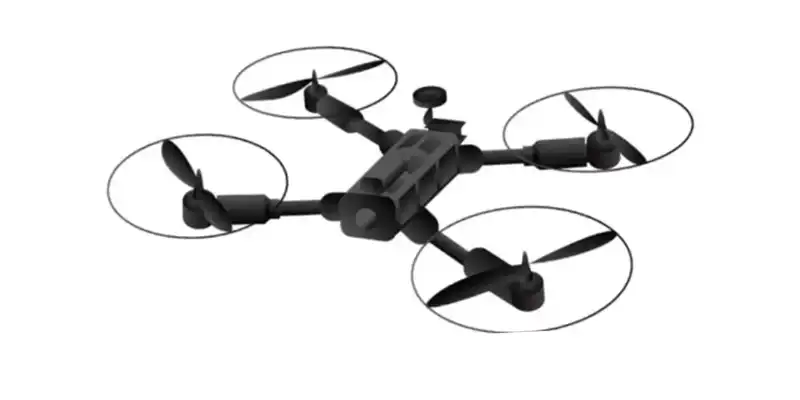
Understanding FPV (First Person View) Drones in Military Applications.
FPV (First Person View) drones are named for their ability to let the operator see exactly what the drone "sees" during flight, thanks to a camera mounted on the drone. This camera provides a live video feed to a display device, such as:
FPV Goggles: These create an immersive experience, making the operator feel as if they are "onboard" the drone.
Screens or Smartphones: Used as monitors to view the live video feed in real-time.
The term "First Person View" originates from the operator’s perspective, similar to piloting an aircraft from within the cockpit. This capability enhances precision and situational awareness, making FPV drones especially effective in military scenarios, including:
Surveillance and reconnaissance: Gathering real-time intelligence over enemy positions while remaining undetected.
Targeted strikes: Delivering payloads with high accuracy against specific targets.
Counter-drone operations: Identifying and neutralizing hostile drones in the field.
The FPV system represents a significant evolution compared to traditional drones, which are controlled by visually observing them from the ground without an immersive view.
The Evolution of FPV Drones in Modern Warfare
The rapid technological advancements in FPV drones and their components have significantly enhanced their combat capabilities. These improvements include increased range and flight time, higher payload capacity, greater resistance to electronic warfare, and adaptability to low-visibility conditions. Additionally, developments in ammunition types, intelligent target acquisition and tracking systems, and the establishment of specialized UAV testing centers and operator training programs have broadened their tactical applications and the variety of missions they can accomplish.
This material provides a concise overview of FPV drones, outlining their general characteristics and examining key tactical methods for their use in combat, particularly in countering enemy forces. These techniques are increasingly adopted by drone operators on the battlefield.
A dedicated section also offers practical advice and recommendations for countering kamikaze drones on the front lines, addressing the growing challenges posed by this evolving technology.
FPV Drone Tactics and Countermeasures
I. General information about FPV drones
FPV ( First Person View) drones are UAVs equipped with a video camera and transmitting real-time images to the pilot’s glasses or helmet (controlled from the first person).
Advantages over quadcopters:
first-person drone control;
instant response and maximum control over the drone;
high maneuverability and flight speed (up to 120 km/h);
resistance to the impact of electronic warfare (due to the modularity of the device, which allows for quick changes to the configuration and settings);
the ability to change the drone design to suit the task;
low cost of the product
Disadvantages include:
average flight duration 7-10 minutes;
flight range (without repeater) – up to 10 km;
the need for selection and high-quality training of the pilot (operational training)
1. Equipment
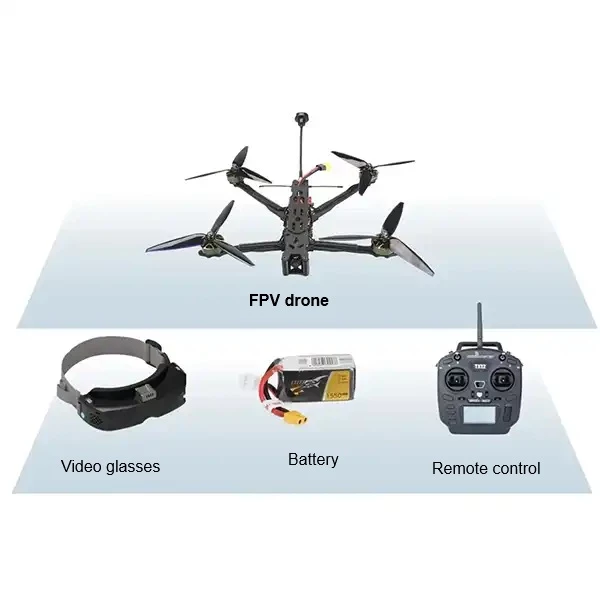
2. General structure of FPV drone
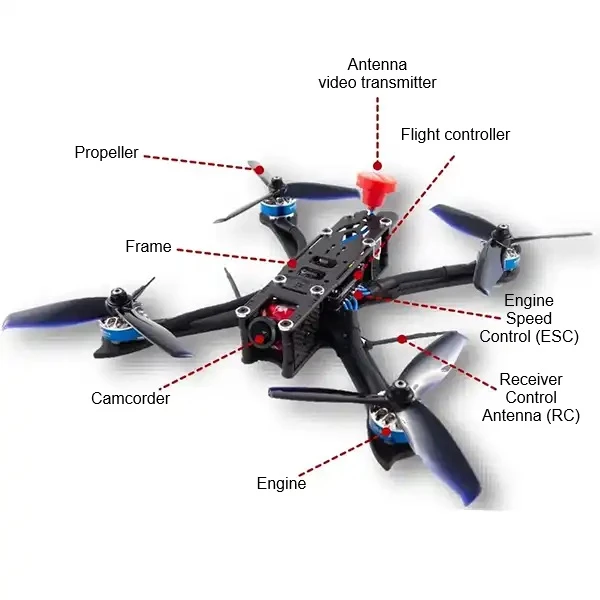
drone size – 7 inches;
load capacity – up to 2.5 kg;
maximum speed (with load) – up to 120 km/h;
flight time with load – up to 10 min;
flight range with load (without repeater) – 10-12 km;
time to prepare for launch – 2 min.
3. Key Roles in UAV Operations
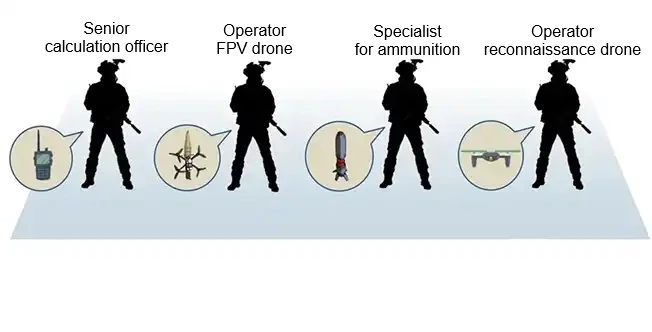
Senior Calculation Officer: Oversees mission planning and coordination.
FPV Drone Operator: Pilots drones for strikes or surveillance.
Ammunition Specialist: Prepares and manages UAV payloads.
Reconnaissance Drone Operator: Operates drones for intelligence gathering.
II. Tactical techniques for using FPV drones
-
Classic: Target identification by a reconnaissance UAV - launching an FPV drone to destroy the target.
This is the most common method of combat deployment. It involves detecting a target using a reconnaissance drone and relaying the coordinates to the FPV drone operator for destruction. The reconnaissance UAV records video footage of the target's destruction.
-
Free Hunting: FPV strikes on pre-identified targets and positions.
This method involves using FPV drones independently to strike previously identified enemy targets and positions.
-
FPV Swarm: Coordinated group strike using multiple FPV drone.
This method involves identifying targets with a reconnaissance UAV and launching a group of kamikaze drones (5-12 units) to destroy them. The reconnaissance drone records the destruction, and the attack can be combined with artillery or mortar fire for added impact.
-
Escorting Assault Groups with FPV Drones: Providing fire support during advances.
This method involves using FPV drones to attack enemy positions in coordination with the advancing assault group. Actions are guided and coordinated through a reconnaissance UAV. FPV drone strikes can also be combined with artillery and mortar fire for enhanced effectiveness.
-
FPV Drone Ambush: Hidden positioning - observation - surprise attack.
This tactic involves positioning an FPV drone in a concealed location near key areas such as roads, intersections, or locations where enemy equipment and personnel are likely to gather. The drone remains hidden and inactive, with only its control channel receiver turned on, awaiting the right moment to launch a surprise attack. When paired with a reconnaissance UAV or signal repeater, the ambush range can exceed 5 km, with a standby time of up to 6 hours. At night, attacks can be triggered using vehicle headlights as targets or by deploying FPV drones equipped with thermal imaging cameras for enhanced accuracy in darkness.
-
Combination Strike: FPV strike on target - dropping ammunition from a bomber drone.
This method combines the capabilities of FPV drones and "bomber" drones to inflict complex fire damage on identified targets. An FPV drone first destroys or disables armored vehicles (or other targets), followed by a bomber drone dropping ammunition. Alternatively, the bomber drone can target personnel or unarmored vehicles to immobilize them, allowing FPV drones to deliver follow-up strikes.
-
Double Impact: Using two or more FPV drones with different charges to breach a shelter.
This method involves deploying multiple FPV drones in sequence to destroy fortified shelters. The first drone, equipped with a cumulative charge, penetrates the barrier. The second drone, typically armed with a thermobaric or fragmentation charge, delivers fire damage to the interior spaces.
-
FPV Trap: Methods to turn drones into bait for enemies.
-
The drone lands and emits a sound signal. When someone approaches or tries to capture it, the FPV operator detonates it remotely using a reconnaissance UAV or a signal repeater.
-
The drone is equipped with a device that triggers self-detonation if its position is altered. A magnetic sensor can also be added to activate the explosion if placed on metal surfaces.
-
A small explosive charge (20-50 g) is embedded in the drone's structure. It activates during any attempt to dismantle the drone.
-
The drone is fitted with a GPS beacon that tracks its location. If moved, the beacon guides a follow-up strike to the new position.
-
The drone’s body is treated with potent toxic substances that cause severe skin blisters on contact, acting as a physical deterrent.
-
-
FPV-Miner: Deploying anti-personnel or anti-tank mines and camouflaged IEDs.
This tactic involves using FPV drones to covertly place anti-personnel or anti-tank mines and camouflaged IEDs (Improvised Explosive Devices) along rotation routes, evacuation paths, or near strategic positions and objects. The goal is to target enemy personnel and equipment with precision and minimal detection.
-
FPV-Sapper: Dropping ammunition or placing charges on mines.
This method is used for demining areas such as roads and pathways. An FPV drone drops ammunition or places surface charges on visible and uncamouflaged mines to neutralize them effectively and safely.
-
FPV Reset: Dropping ammunition on target.
This tactic involves using an FPV drone to drop ammunition on targets, such as personnel in open areas or poorly protected shelters (e.g., "holes"). A reconnaissance UAV guides the FPV drone to the target. In some cases, ammunition with toxic substances has been used. Additionally, this method is often employed to deliver payloads to friendly troops in the field.
-
FPV-Dragon: Spraying incendiary mixture over enemy positions.
This tactic involves using an FPV drone equipped with a thermite charge, typically based on a 120-mm artillery incendiary munition, to ignite and disable enemy positions, equipment, exposed ammunition, and other assets. The incendiary mixture is sprayed from an altitude of 20-50 meters, with a burning time of up to 2 minutes and a temperature exceeding 2300°C.
-
FPV-PVO: UAV destruction.
FPV drones are deployed to combat reconnaissance UAVs and hexacopters. Upon detection of UAVs through radio-technical means (operating at altitudes up to 3 km and speeds up to 110 km/h), FPV drones are launched to intercept and neutralize them. The drones disable targets by detonating a fragmentation charge upon close approach or by ramming. Target designation is provided by the radar operator.
-
FPV-Saboteur: Covert deployment of sabotage and reconnaissance drones.
This tactic is employed by sabotage and reconnaissance groups to destroy or disable enemy military equipment and infrastructure. Kamikaze FPV drones (4-6 units) are covertly installed near the target, typically within 2-3 km, and set to "standby" mode. The drones are remotely activated via a GSM network signal to strike pre-determined targets using pre-loaded coordinates.
-
FPV on the Mother Drone: Extending the combat range.
To extend the combat range of FPV drones, a larger UAV, referred to as the "mother drone," is used. These "mother drones" can be of both fixed-wing (aircraft) and rotary-wing ("copter") types and often double as signal repeaters. They carry two or three FPV drones as payload, significantly increasing their operational range to up to 60-70 km, depending on the type of mother drone. Additionally, unmanned boats (UBCs) can also serve as "mothers" for FPV drones, offering a versatile platform for launching drones in both land and maritime operations.
-
FPV on Wires: Ensuring stable drone control.
To maintain stable control of FPV drones and counteract electronic warfare systems, drones equipped with fiber-optic cables are being used. This setup ensures reliable communication and guaranteed target destruction at ranges up to 10 km, and in some models, up to 25 km. A key advantage of this method is the high clarity of the video feed throughout the drone's route. Operational considerations include avoiding sudden maneuvers and steering clear of fires or hazards along the flight path.
-
Inspection of Buildings: Monitoring and control of interiors.
Short-range FPV drones, known as "tiny whoops" (microcopters with blade protection), are used to detect enemies and monitor the interiors of buildings during assault operations. These drones are compact and lightweight, with general specifications including a diameter of up to 100 mm, a weight of up to 50 g, a flight time of up to 4 minutes, and a communication range of up to 500 meters within buildings.
-
FPV-Swearing Speaker: Psychological operations against the enemy.
To weaken the morale and psychological state of enemy personnel and pressure them into surrendering, FPV drones equipped with speakers are deployed to broadcast audio messages over their positions. These drones typically hover at heights of up to 50 meters to maximize the impact of their broadcasts.
-
Flying Leaflets: Dropping informational materials from an FPV drone.
FPV drones are used to drop leaflets as part of psychological operations targeting enemy personnel and the local population. These drones can carry up to 2 kg of printed materials, equivalent to approximately 200 leaflets, and release them over enemy positions to disseminate messages.


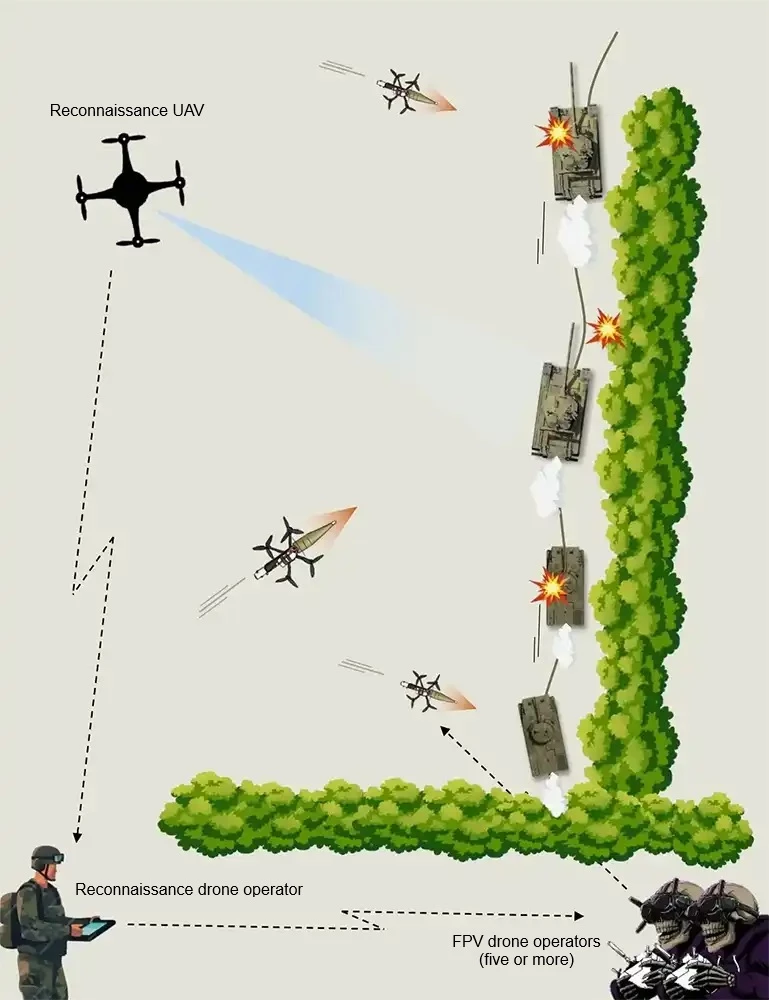

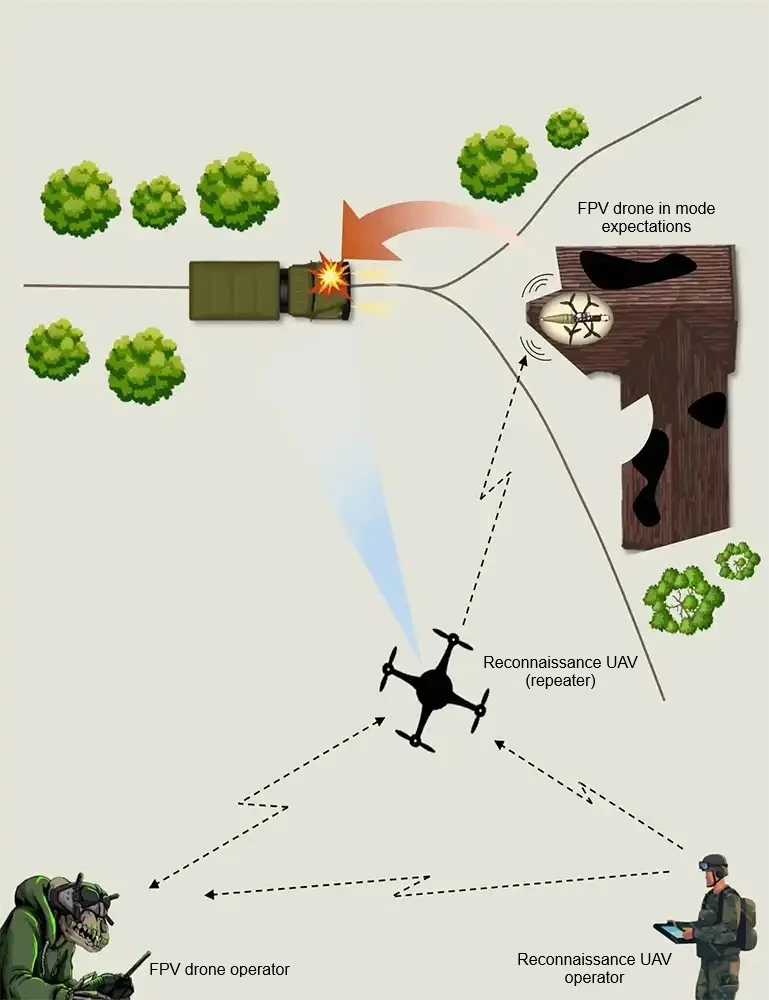





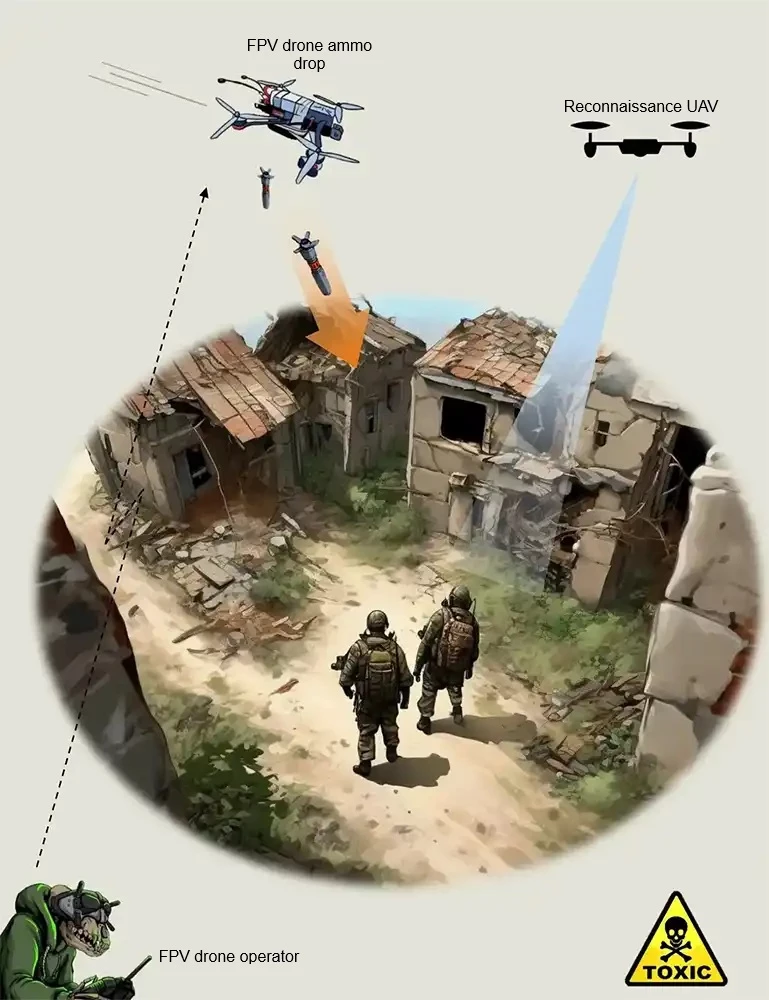


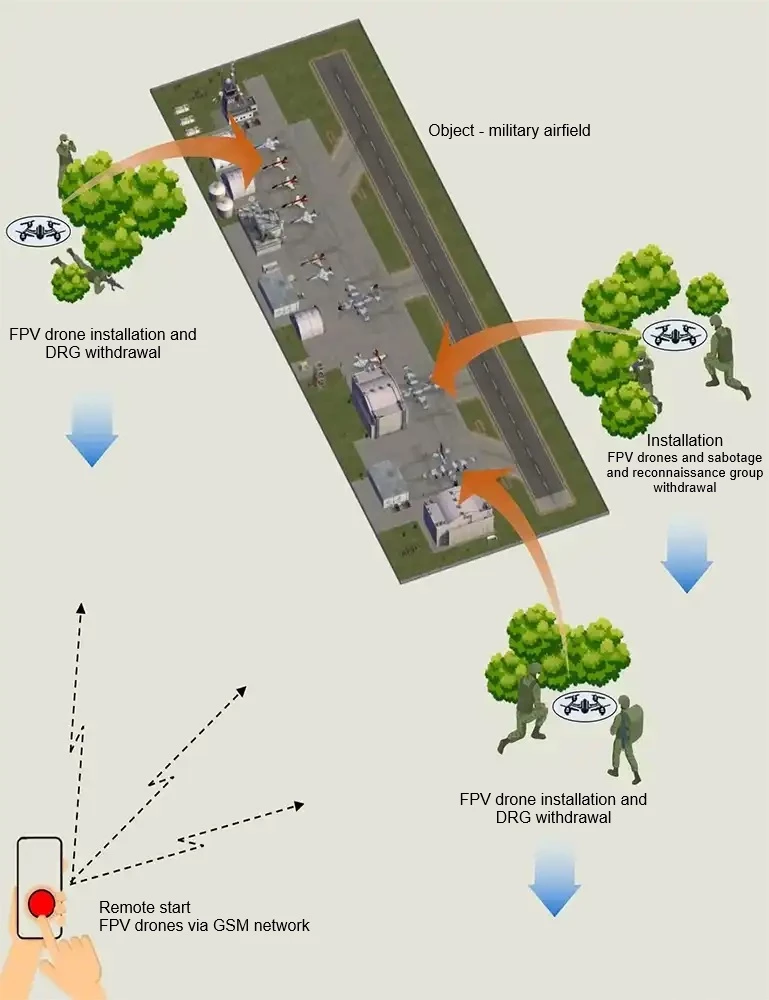





III. Methods of countering FPV drones
An effective defensive strategy against FPV drones involves a comprehensive approach that incorporates both active and passive measures. These must be implemented collectively by the unit and individually by each serviceman.

Active events include:
Identification and destruction: Detection and elimination of kamikaze drone operator crews involve identifying potential launch sites by looking for signs such as antennas, areas specifically prepared for FPV drone launches, traces of ammunition handling (e.g., dismantling, packaging, or boxes), inconspicuous passenger vehicles, and repeaters placed on high-rise buildings or other infrastructure.
Early Detection of UAVs: This can be achieved visually, by sound, or through signals from a detector or analyzer. Notification: Receiving a command or message from a senior officer, observation post, or nearby units about the presence of a drone in your operational area.
Electronic Suppression: Disrupting radio frequencies used for control channels, video signal transmission, and satellite navigation through electronic warfare systems.
Minimizing Time in Potentially Dangerous Areas: Reducing exposure by utilizing high-speed vehicles, such as an Enduro-type motorcycle, which can cover 5 km in just 4 minutes at a speed of approximately 80 km/h.
Fire Impact: Destroying drones using small arms, primarily smoothbore guns, at a range of up to 50 meters.
Mechanical Impact: Capturing drones at close range (20-30 meters) using specialized tools like “net throwers.”
Maneuver: Personnel actions to avoid drone strikes, such as dispersing, taking cover, or moving actively in open areas when under threat.
Logistical Support: Delivering ammunition, water, and food to front-line units using “heavy copters” and ground-based robotic systems, which can also evacuate the wounded.
Optical Countermeasures: Future methods include disrupting drone cameras with laser devices that emit a wide light beam.
Passive activities:
Enhanced Position Fortifications: Preparing anti-drone niches and "holes," adding bends at dugout entrances, and installing hanging protective nets and barriers.
Camouflage: Using irregularly shaped camouflage nets placed 0.3-0.5 meters from equipment, positioning in shaded areas like trees, bushes, or inside destroyed buildings, applying heat-protective covers, and monitoring for signs visible to drones.
False Positions: Creating decoy positions equipped with heat and light sources, using models of military equipment, including non-operational vehicles, to imitate activity.
Protective Nets: Installing fishing net screens along rotation routes for personnel evacuation and delivery of ammunition, water, and food.
Hanging Protective Elements: Setting up canopies, awnings, or "domes" to shield equipment and electronic warfare systems.
Weather and Terrain Considerations: Adapting plans and movements to account for weather, terrain features, and time of day.
Aerosol and Smoke Screens: Deploying aerosol curtains and creating smoke sources at positions, along routes, or in decoy areas.
General Recommendations for Countering FPV Drones (Based on Battlefield Experience)
The use of UAVs at the front is increasing rapidly. Constant drone activity in the air has led to a decentralization of forces and a reduction in troop numbers. Where a platoon was once stationed, now a squad suffices. Instead of a traditional support structure, there are now three defensive "holes," each manned by two soldiers. Both sides are minimizing movements in the frontline (LBS) area. A single armored vehicle ("armor") can attract as many as a dozen drones, and 2-3 drones often pursue individual soldiers. In the LBS zone, reconnaissance drones, "bomber" drones, and FPV crews rotate through sectors, conducting surveillance and preparing for action. Some search for targets, while others strike them.
Disguise
Move and hide in the shade of trees and slopes. Avoid sudden movements and running, as they are noticeable. Twilight, night, fog, and rain provide safer conditions. Protective capes from "hothouses" are useful.
Camouflage equipment in forest belts or near buildings and hangars. Change locations often, use simple camouflaged canopies, and cover car windows to prevent glare. Place equipment on the opposite side of the enemy’s location (e.g., south side if the enemy is north).
Keep transport away from positions in hidden areas for quick relocation. Collect garbage in bags and pits. Scattered trash like ration packages, cans, and plastic bottles reveal positions. Use a drone to check for unmasking signs in your area.
Use large quantities of camouflage nets. Change their configuration to create unclear, blurry silhouettes, making detection harder. Hide satellite dishes in holes and cover them from both daytime and thermal imaging cameras.
Create false positions with signs of activity. Use mock-ups of military equipment or disabled transport and simulate their use. At night, make fires in empty shelters or place "new" candles in trenches.
Practice light discipline at night. Light from cigarettes, campfires, flashlights, phone screens, and vehicle headlights attract drones like moths to a flame.
Conversations should occur in cover. Avoid gathering in groups with cigarettes or wandering around aimlessly. Notify others if leaving on command. Movement during the day and heat reflections at night are the main detection criteria. Stay quiet, communicate in whispers or gestures, and listen carefully to sounds.
Fortification and transport
When building a trench, include a side niche at the bottom to protect against shrapnel, FPV strikes, and ammunition drops. Design dugout exits in an "L" shape and hang a protective blanket at the entrance. Add a second entrance as a backup in case the primary one is blocked.
Set up anti-drone cord curtains in front of positions, made of 4-5 mm thick ropes. Each curtain should be 6 m long, up to 4 m high, with a 20 cm interval between ropes.
Install fishing net screens (up to 80 m long, 4 m high, and costing around 10 euros) as additional protection. These nets are difficult for drone operators to spot. Add awnings and canopies for extra shelter.
Prepare smoke grenades in advance at positions (20-30 m away) for activation during kamikaze drone threats. Each soldier should carry instant-action smoke grenades.
Add protective elements to vehicles, such as "visors," "barbecues," shields, nets, chains, and anti-fragmentation rubber pieces. Ensure these do not overload the vehicle while increasing crew survivability against drones.
An ideal electronic warfare setup at platoon positions includes a spectrum analyzer, UAV detector, FPV video interception device, portable broadband "dome" suppression systems, and mobile "suppressors." Vehicles should have mobile "dome systems."
Equip vehicles with proven electronic warfare drone suppressors. Avoid covering them with camouflage nets and monitor battery levels to ensure they remain operational during missions.
Install onboard electronic warfare systems to combat UAV "hunters" targeting aircraft-type drones.
To disrupt an approaching enemy FPV drone's video transmission channel, use an FPV monitor or goggles to find its frequency (typically 5.8 GHz). Set your drone's video transmitter to the same channel with maximum power to create interference.
Use mechanical robotic platforms and "heavy" drones for transporting ammunition, water, food, and evacuating the wounded to minimize personnel losses from FPV drone attacks.
Actions when a drone is detected
Always listen carefully and remain aware of sounds in the "sky." First, detect UAVs by sound (especially at night), then visually. Notify others promptly and treat all UAVs as hostile.
Learn to identify the difference between a Maywick and an FPV drone by sound. Maywicks are quieter and smoother, while FPVs are more piercing with sharp sound changes during acceleration.
To enhance safety, plan movements based on an analysis of enemy drone activity in the specific combat zone. Avoid moving during predictable “gray” times known to the enemy, such as:
* Patrols and reconnaissance for area control and information gathering;
* Logistical transfers and deployments for supplies and strategic positioning;
* Repositioning and withdrawals for tactical advantages or evacuations;
* Diversions to confuse the enemy.For a detailed guide on mitigating the risks of predictable movements in conflict zones, explore : Mitigation Strategies for Predictability.
Avoid open, exposed areas. Instead, move along vegetation or plantings. In populated areas, progress from one building to another. When moving as a trio, maintain a 5-meter distance between each member and move discreetly toward shelters or checkpoints.
A reconnaissance drone often precedes an FPV. If you spot an enemy UAV while moving, don’t lead it back to your unit. Take cover, wait, and observe without revealing your position. When landing, lean against a tree trunk and remain still.
Control the "sky" in sectors while moving. Keep a distance, note nearby shelters (e.g., destroyed buildings, holes, bushes), and prepare for a quick dash if under drone threat. Avoid gathering in one spot; prioritize dispersion, maneuver, and speed.
If you hear an FPV drone, take immediate cover. In open areas, make sudden, sharp movements to exit the operator’s observation sector. Fall to the side during an attack. Practice “shuttle” running to increase survival chances.
If a drone is within 20-30 meters, don’t stay still or “freeze.” React quickly and keep moving to avoid detection and attack.
Firing small arms at drones is usually ineffective due to their size and speed. Additionally, shooting makes you a stationary target. At close range (up to 50 meters), use hunting or pump-action shotguns (preferably with two shooters). Practice on skeet shooting to improve readiness.
There have been instances where the drone operator toys with the target. However, if you act quickly and skillfully by dodging and taking cover (even a 40 cm tree trunk can provide some protection) while attempting to attack the drone by throwing objects like sticks or other items, your chances of survival improve. Such actions have been observed in real situations.
When driving a vehicle, always monitor the “sky” from the rear and flanks, as up to 80% of FPV drone attacks target the sides and rear of vehicles.
In dangerous areas, move at maximum safe speed and avoid long routes. If a kamikaze drone is detected, move to the side (preferably toward forest plantations or buildings), stop, and quickly disperse. Escaping along the route is unlikely.
When the vehicle stops, exit immediately and efficiently. Do not hesitate, crowd, or argue about tasks like unloading ammunition. Delays make you a high-priority target, and every second counts.
High-speed vehicles like dirt bikes, buggies, and quad bikes with skilled drivers enhance survivability and improve cargo logistics. Electric models provide silent movement, helping drivers and passengers detect drones earlier by sound.
Extreme driving requires rigorous training. Practice day and night to recognize landmarks in daylight and navigate effectively after dark.
If you spot an FPV drone on the ground—especially if it emits a beeping sound near your position—exercise caution. Avoid approaching or attempting to claim it as a trophy; it could be a trap.
Do not approach from the camera side, as the operator may be monitoring. Mark the drone's location with a visible marker and report it to your commander. Let a trained specialist handle it safely to minimize risks.
IV. Conclusion
The rapid advancement and adaptation of FPV drones for modern military operations have resulted in a substantial expansion of the variety of combat missions they can undertake.
The demand from combat units for trained and well-equipped kamikaze drone crews currently outpaces the available supply on the military market. The continued innovation and development of this type of weapon will undoubtedly drive the exploration and implementation of new countermeasures, including electronic, optical, and mechanical solutions. Furthermore, it is likely to result in the formation of specialized units dedicated to both deploying these drones and countering their use effectively.
In the near future, every serviceman in combat units is likely to be involved in some aspect of countering drones. The competition in the drone versus anti-drone battlefield is only just beginning, signaling an evolving and intensifying technological arms race.
